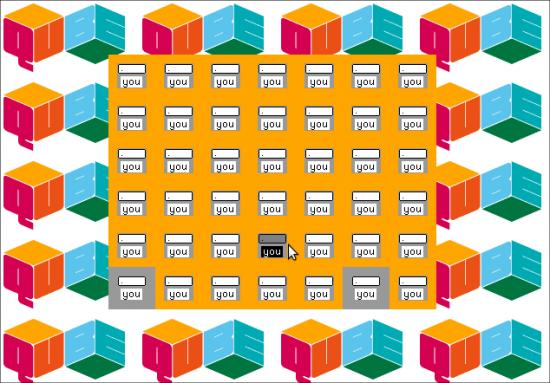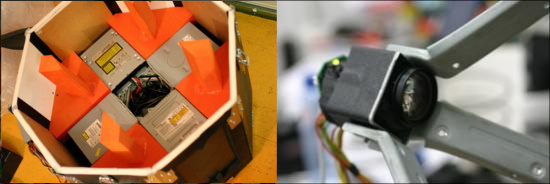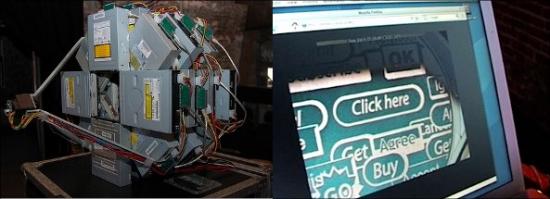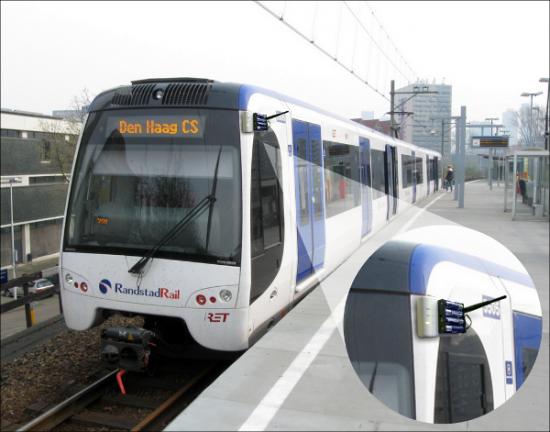



Meat Space and the World Inside the Machine
Danja was an Artist in Residence at Furtherfield’s HTTP Gallery space between the 1st March – 9th April 2010. A Russian born computer artist currently living between Berlin and Rotterdam. Working with diverse methods, technologies and materials Danja ridicules the contemporary affection for digital life and questions the global tendency for cyborgination. Danja co-founded media-lab moddr_ in 2007 which is a joint project at Piet Zwart Institute alumni and WORM Foundation. Based in Rotterdam moddr_ is a place for artists and hackers, engaging with critical forms of media-art practice.
The email interview took place a few weeks after his residency. A recent collaborative project that many readers may already know of, by Danja Vasiliev, Gordan Savicic and Walter Langelaar, all part of moddr.net lab is, Web 2.0 Suicide Machine, which lets you delete your social networking profiles and kill your virtual friends. Danja is certainly prolific, he is also collaborating with New Zealander artist, Julian Oliver who is now based in Berlin. This interview unearths some of the ideas and intentions behind Danja’s personal works, asking what motivates him to use computers, technology and networks, as well as understand more the social contexts and implications of his endeavors.
Marc Garrett: You’ve been on the residency at Furtherfield’s HTTP space http://www.http.uk.net/ for a few weeks now. Before we discuss Netless, the project you have been researching here and some of your other recent works, I think it would be interesting to know about some of your earlier works first. Before the turn of the century you made various net.art pieces. What I find interesting here is that whilst you were creating these works you were also parodying net.art at the same time, was there any particular reason for this kind of approach?
Danja Vasiliev: “HTTP” as an abbreviation was a very significant thing for me throughout the last decade, now having to stay at a place bearing the same title feels like a necessary experience indeed. Fifteen years ago WWW was something very new in Russia and besides the new dial-up aesthetics and world-wide means it brought a complete new layer of existence – “netosphere”, which made my youth. I was trying to understand the technology, though not being of a scientific kind I did it by monkeying around with artworks of others. Later I heard it was called “Open Source” approach. The Website “koala.ru” http://koala.ru.k0a1a.net became a collection of expressionist pages, each page had its own story and often a narrative. Back in the day my arsenal was naturally limited: HTML3, GIF89a (animated) and JavaScript1.2. It felt challenging to work with those tools, file-size was aesthetically just as important as letter-case, and I liked it… I haven’t changed any of the pages since 2002, iirc. The greatest source of my inspiration (image and code -wise) of that time was the baddest of all Superbad – I loved the wackiness yet elegance weaved into the piece. My attraction to /random redirect/ comes from there.

MG: What draws you into using computers in your art practice?
DV: It must be the conflict between the everyday technology and digital life. I’m exploring that edge between the meat space and the world inside the machine. Machine in this case is not just a PC – a single computer is only a part of the network. Acting on those parts adjusts the behavior and perception of the whole – I’m interested in that. Computer hacker attitude and methods are very influential, my works are often merely illustrations of those technological interventions. It makes much more sense to me to try to confront or challenge the technology (and the users) rather then to celebrate the achievements. ‘IT’ today is what politics were yesterday – it and its aesthetics owe to be questioned, broken into pieces, interrogated, sabotaged, reflected upon and ridiculed.
MG: On the NETTIME list on 1st July 2008, Eric Kluitenberg wrote an intriguing essay about your work titled “Turning the machines inside out”.[1] He also discusses something which is close to one of my own interests, about the world as a kind of Interface, metaphorically, virtually and materially “The world according to Rossler is defined by that what transfers between the observer and the “real” world at the interface. It is the interface to the world that defines what can be observed about the “real” world.” Kluitenberg.
Before we talk about Kluitenberg’s concepts regarding his thoughts around your work, I would like to know what your own considerations are in respect of the “World as Interface” and what this means to you?
DV: Well, it always surprises when I come across some theoretical implications confirming, destroying or otherwise connecting to my own work. Perhaps that is why I got to be a maker rather then a thinker – I could never describe the topic I was covering with m/e/m/e 2.0 in a such a profound way as Eric Kluitenberg did. However incapable of posing a verbal question, my intention was indeed to discuss and demonstrate that effect of alienation created by the very medium (or shall I say the interface) of the Web. A System that promotes itself to the users as a fair substitute for reality and provides services for talking, seeing, being and so on, yet fails to escape its own binary jail, i.e. fails to become indeterministic. This determined interface creates determined world – web applications are uploaded straight into our brains. In my perception what we are seeing now is rather reversed or multiplexed inclination of “World as Interface” idea, when devices used for participation in-World and auxiliary systems created around to assist the process, all of this _is_ the World for its users.


MG: Kluitenberg in his essay, viewed your m/e/m/e/2.0 to be part of a tradition “(inadvertently or not) in the best company of a long tradition of “avant-garde” artists who created various sorts of absurd, ironic, impossible, sadistic, insane or ridiculous machines. His likes are the creators of ominous bachelor machines (Duchamp, Lautreamont, Picabia, Roussel, Kafka), self-destructing machines of the Tinguely type, right down to the magically autistic robotic anti-sculptures of Allan Rath.”
For me, what links m/e/m/e/2.0 to our contemporary world and its ever increasing networked existence “and what we know it to be now” is, its playful and direct link and reference to the Internet. It could not be what it is without the Internet, in which millions have been and are still being taught how to adapt and reconfigure relationships with others, and ourselves. We have become part of the networked driven interface via this socially engineered activity. Would it be presumptuous of me to consider m/e/m/e/2.0 to be a kind of portrait, or a physical re-representation of the human mind or perhaps “head”, metaphorically?
DV: m/e/m/e 2.0 is a manifestation of the absence of any human traits in an act of network communication. Of course it is impossible to demonstrate this without the involvement of the main suspect – the object, the sculpture – is only a half of the work, another half is the Internet. Whenever the piece is not online – it is not complete, and as such – kept in a wooden crate. What “m/e/m/e 2.0” ultimately represents is the physicality of the fellow Internet user on the other end of the wire. It is a device that converts digital instances (copies) of netizens into humanoids, adding flesh around immaterial skeletons. By the analogy to what’s known as “modem” (MOdulator-DEModulator, a device used for digital communication over analog, physical mediums), “m/e/m/e 2.0” is a “semi-modem” or just “mo” without “dem” – it materializes (modulates) without caring to convert back into binary format. It lets the users enjoy their own bodily presence while online; much like the famous FuFme device only with some corrections to the current state of things.
The machine of m/e/m/e 2.0 allows its visitor to sense not only the surfaces of the system but also to get into an strange relationship with the concurent users. The $USER begins to understand intimacy over a distance. The mechanical body can not be re-multiplied to a spontaneous number of requests, instead all of the users come to share one analogue broadcast medium. Whenever someone clicks to open a new link, the information is transmitted to all connected users, “meshing” and colliding their sessions. Seemingly a constraint becomes a feature – unbodied cyberspace gets filled with physical presence. The consequence is that it turns web browsing into a broadcast, collective group activity without any predefined rules. Each page is a part of info-system contained with-in m/e/m/e 2.0, all pages are hyper-linked into a mesh that has no beginning or end.

MG: During your residency here in London, you worked on another project called Netless. Could you explain what the project does and why you have chosen to embark on such a venture?
DV: I’m researching a digital communication strategy or technique that would be free from the “panoptical” effect of the Internet. It is too easy to observe and trace users connected to the global network – partly because of the way it is structured, as well as its reliance on the corporate communication channels. It is something about “net neutrality”.
Netless is an attempt to create a new network, alternative to the Internet. More precisely – networks within existing city infrastructures, possibly interconnected into a larger network alike the Internet. Netless is not dependent on specialized data carriers such as cables or regulated radio channels. In fact, there is no permanent connection between all of its hosts (peers) at all – it is net-less. The network is based on the city transportation grid, where traffic of the vehicles are the data carriers. Borrowing the principals from the Sneakernet concept, the information storage devices are physically moved from point A to point B. Numerous nodes of the netless network are attached to city buses or trams. Whenever those vehicles pass by one another a short-range wireless communication session is established between the approaching nodes and the data they contain is synchronized. Spreading like a virus, from one node to another, the data is penetrating from the suburbs into the city and backwards, expanding all over the area in the meanwhile. That broadcast data can be picked-up by anyone.

…the similarities between city transportation maps and circuitry of modern networks are not accidental. their purposes are identical – to provide efficient transport flow between all the locations of the area they cover. routes are designed to match the necessary throughput without congesting at peak times. D.Vasiliev.
MG: What kind of information will be shared within a “Netless” system? Also, are these ad hoc mini-networks going to be attached onto vehicles as secret transmitters?
DV: Constrained by the bandwidth limits Netless networks will work most effectively when dealing with short messages. Technically speaking – “ascii” text, or short base64 encoded binaries/images. Textual data is playing well together with human brains – we often do not need to read a complete sentence to understand the meaning – this would be a great way of keeping the data traffic down. If an error occurs during the transmission of a text message, it can be easily “repaired” by the recipient’s brain – less work for hardware, more information can come thorough. The Netless network integrates into the citizens’ living infrastructures, its data-processing and error-correction routines are outsourced to the users. This is a “hybrid” (parasitic) system, it requires the “human” as resource in order to function.

It would be very interesting to collaborate with some city transportation company, like the one that runs all the buses across London, Arriva. It blankets all areas pretty well as I discovered during my residency at HTTP and if every bus would carry a “Netless” node – the performance would be amazing. That said, it wouldn’t be smart to make “Netless” depend on any commercial entity. Instead I’d rather encourage people to follow up on the project development and start putting together their own “Netless” nodes and take those on everyday travels within the cities. The strength (and bandwidth) of any mesh-network grows proportionally to the amount of nodes involved into the network, thus – (random) network maintenance is the sole responsibility of its users..

MG: This idea of independent nodes/activities of communication, asking us to consider the notion of what it would be like to be “off the grid”; is an important issue. It reflects wider concerns around individual freedoms and civil liberties, in an age where corporations are channelling our everyday digital behaviours towards, a more “official” form of mediation. Where top-down, imposed digital infrastructures are dominating the interface of who our digital, data-bodies are, whilst having control and access to our content, not on our terms. It also reminds me of the battle between pirate radio and institutionally implemented radio broadcasts, as in who owns the medium and what is perceived “correct” information when sharing with others?
DV: Definitely, reclaiming the medium (or the net-space for this matter) does not happen on paper or during some international conference on the topic of net-neutrality. Such changes in disposition of the forces – corporate state on one hand and personal interest/freedom on other is a tedious process; approached top-down it might take ages to complete. Revolution starts on the streets! Rather than having endless debates and explaining to the officials about how and why “Inter Net” is different from “Closed Circuit Tele-Vision”, we respond proactively, ahead of the regulations; creating our own communication strategies. I see my role here in exemplifying the conflict and its resolution.
MG: To the more traditional art practitioner out there who may not be so dedicated or as involved as yourself, in using computers and technology as part of the creative process; how do you manage to keep the balance, maintain the essence of what you do, as art?
DV: I’m for sure not “doing art”. I reflect on certain things, certain events, topics. Those often happen to have technological origins – nothing very surprising nowadays. My works are somewhat “improved” versions or “hacks” of our every-day technology and thus – our life. It is an essential thing for me to work with the same means as the means of the subject of my criticism – e.g. /misuse/ a piece of technology to demonstrate its other potentials; it is a more constructive approach.
MG: What other projects can we expect to see in the future other than what we have discussed so far?
DV: More technological interventions… and I was also thinking of building a railway model! People should check http://k0a1a.net more often.
MG: Will do, and thank you very much for the conversation…
DV: Thank you, nice chatting…
—
danja vasiliev
http://k0a1a.net
Danja was also interviewed by Marc on a Furtherfield, radio broadcast 6th April 2010 – Resonance FM. http://www.furtherfield.org/resonancefm.php